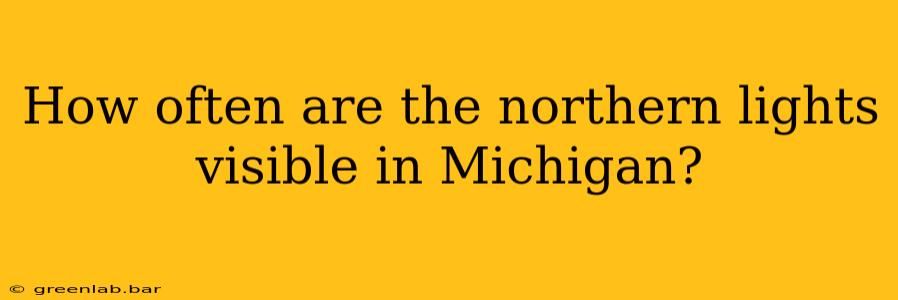The aurora borealis, or Northern Lights, is a breathtaking celestial display that captivates viewers with its shimmering curtains of green, sometimes tinged with purple, red, or blue. While not as frequent a sight as in Alaska or Scandinavia, Michigan residents do have a chance to witness this natural wonder, although the frequency and intensity vary greatly. So, just how often are the Northern Lights visible in Michigan?
The Factors Influencing Aurora Borealis Visibility in Michigan
Several factors determine the visibility of the aurora in Michigan:
-
Solar Activity: The sun's activity is the primary driver. Solar flares and coronal mass ejections (CMEs) release massive amounts of charged particles that interact with the Earth's magnetic field. Stronger solar activity leads to brighter and more frequent auroras. Monitoring space weather forecasts is crucial for predicting aurora viewing opportunities.
-
Geomagnetic Storms: These storms, caused by solar activity, disrupt the Earth's magnetosphere, allowing charged particles to penetrate further south, increasing the chances of seeing the aurora at lower latitudes like Michigan's Upper Peninsula. The strength of the geomagnetic storm directly impacts the aurora's intensity and visibility.
-
Light Pollution: Michigan's population centers, particularly in the Lower Peninsula, experience significant light pollution. This obscures the fainter auroras, making them much harder to see. The darker skies of the Upper Peninsula, especially in remote areas far from cities, offer a far better chance of aurora viewing.
-
Time of Year: While auroras can occur year-round, they are more easily visible during the long, dark nights of autumn and winter (September to March). The longer periods of darkness provide more opportunities to catch a glimpse of the aurora.
-
Cloud Cover: Unfortunately, cloud cover can completely obstruct the view of the aurora, regardless of solar activity. Clear, dark skies are essential for optimal viewing.
How Frequently Can You Expect to See the Northern Lights in Michigan?
There's no simple answer to how often the Northern Lights are visible in Michigan. Some years might bring several spectacular displays, while others may have none visible to the naked eye. However, based on historical data and space weather patterns:
-
Upper Peninsula: Residents of the Upper Peninsula have a higher chance of seeing the aurora than those in the Lower Peninsula. Several times a year, strong geomagnetic storms may result in visible aurora displays. However, these displays might only be faint glows or subtle colorations on the northern horizon. A truly vibrant aurora in the Upper Peninsula might be seen only a few times a year, possibly less.
-
Lower Peninsula: The chances are significantly lower in the Lower Peninsula due to light pollution. Bright, easily visible auroras are extremely rare. Faint auroral displays might occur more often, but they're usually difficult to spot without specialized equipment and dark sky conditions.
Tips for Increasing Your Chances of Seeing the Northern Lights in Michigan
-
Check Space Weather Forecasts: Regularly monitor websites and apps that provide space weather predictions, such as the Space Weather Prediction Center (SWPC). These forecasts indicate the likelihood of geomagnetic storms.
-
Head to the Upper Peninsula: Escape the light pollution of cities and travel to the darkest locations in the Upper Peninsula.
-
Find Dark Sky Locations: Seek out areas with minimal light pollution for the best viewing conditions.
-
Be Patient and Persistent: Aurora sightings require patience. Even with favorable conditions, the aurora may appear subtly or intermittently.
-
Use a Light Pollution Map: Use online resources to find the darkest areas in Michigan.
While witnessing the Northern Lights in Michigan isn't a guaranteed annual event, with a bit of preparation, knowledge of space weather, and a healthy dose of patience, you can significantly increase your chances of experiencing this unforgettable celestial spectacle.

